Exploring Leadership and Organizational Change Management Strategies
VerifiedAdded on 2020/05/28
|18
|4832
|306
Essay
AI Summary
This essay critically evaluates the relationship between organizational change and leadership, emphasizing its significance in today's business environment. It highlights that successful change management heavily relies on effective leadership, which acts as the primary advocate and catalyst for change. The essay explores relevant theories, including Lewin's Change Management Model and McKinsey's 7S framework, to establish the connection between leadership and organizational change. Real-world case studies, such as the Nissan Motor Company under Carlos Ghosn, are analyzed to support the importance of leadership in implementing change management procedures. Different leadership styles, like democratic, transactional, and transformational leadership, are examined for their impact on change implementation, with a focus on how leaders understand the need for change, provide guidance, and motivate employees to adapt to new business environments. The essay underscores the need for leaders to adapt their style and implement effective communication strategies, reward systems, and organizational structures to foster successful change management.
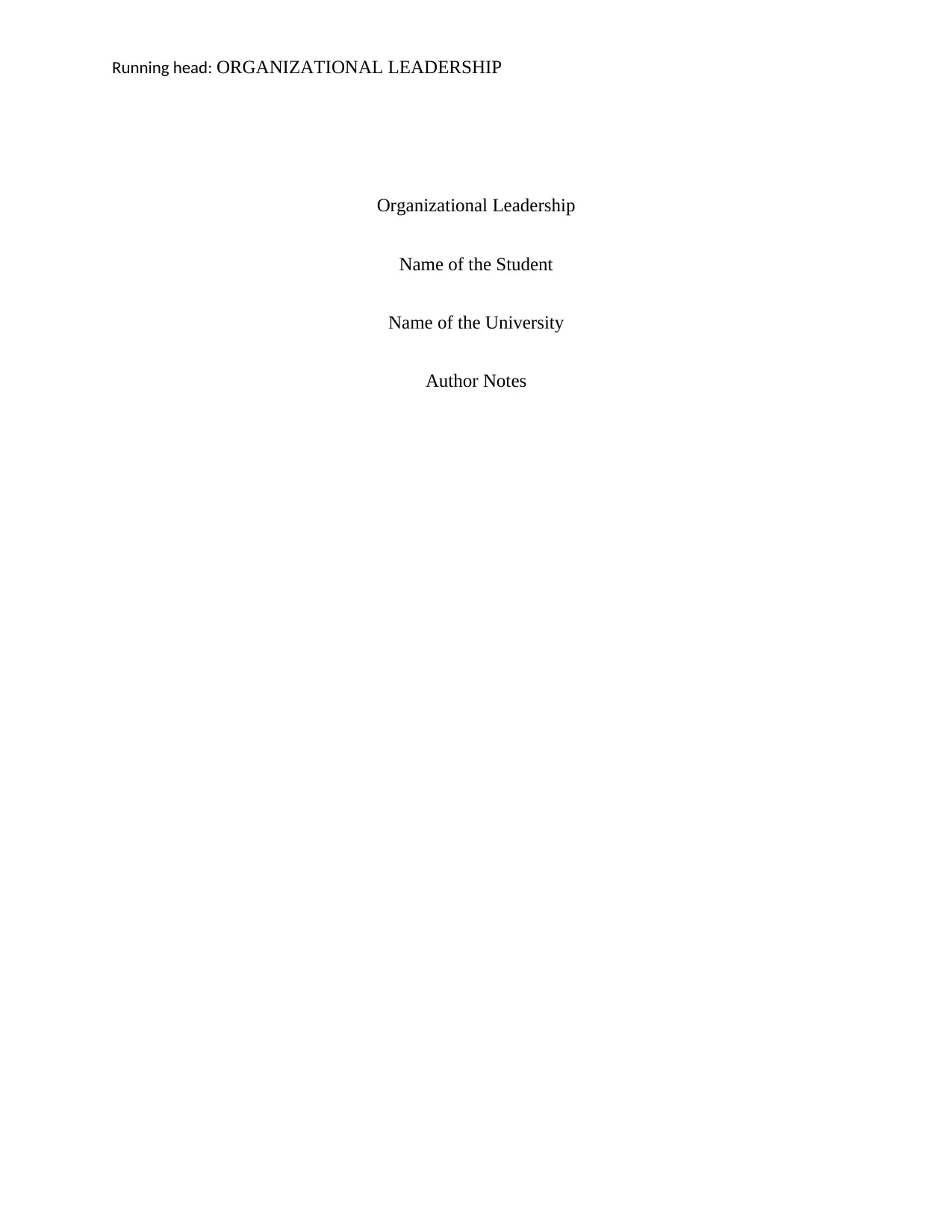
Running head: ORGANIZATIONAL LEADERSHIP
Organizational Leadership
Name of the Student
Name of the University
Author Notes
Organizational Leadership
Name of the Student
Name of the University
Author Notes
Paraphrase This Document
Need a fresh take? Get an instant paraphrase of this document with our AI Paraphraser
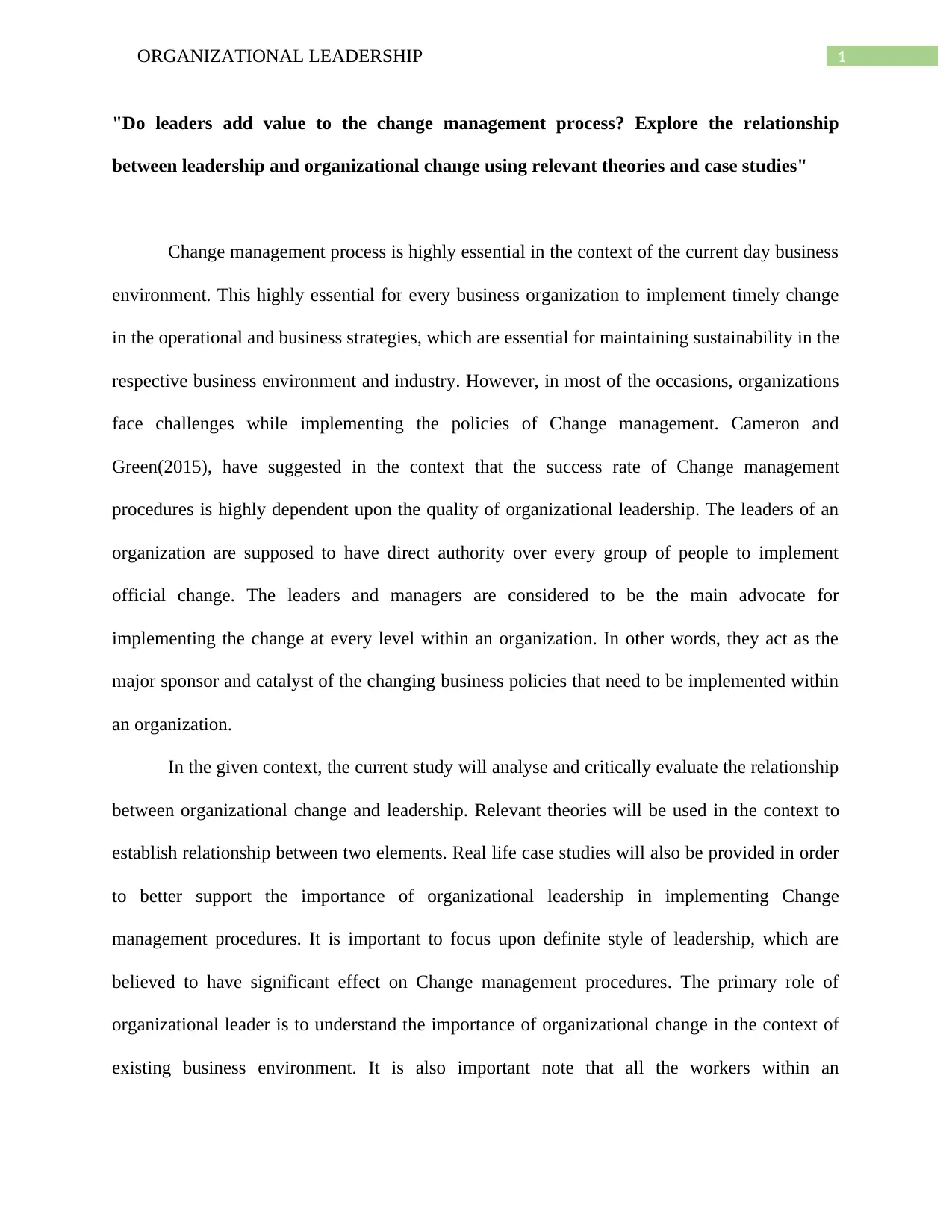
1ORGANIZATIONAL LEADERSHIP
"Do leaders add value to the change management process? Explore the relationship
between leadership and organizational change using relevant theories and case studies"
Change management process is highly essential in the context of the current day business
environment. This highly essential for every business organization to implement timely change
in the operational and business strategies, which are essential for maintaining sustainability in the
respective business environment and industry. However, in most of the occasions, organizations
face challenges while implementing the policies of Change management. Cameron and
Green(2015), have suggested in the context that the success rate of Change management
procedures is highly dependent upon the quality of organizational leadership. The leaders of an
organization are supposed to have direct authority over every group of people to implement
official change. The leaders and managers are considered to be the main advocate for
implementing the change at every level within an organization. In other words, they act as the
major sponsor and catalyst of the changing business policies that need to be implemented within
an organization.
In the given context, the current study will analyse and critically evaluate the relationship
between organizational change and leadership. Relevant theories will be used in the context to
establish relationship between two elements. Real life case studies will also be provided in order
to better support the importance of organizational leadership in implementing Change
management procedures. It is important to focus upon definite style of leadership, which are
believed to have significant effect on Change management procedures. The primary role of
organizational leader is to understand the importance of organizational change in the context of
existing business environment. It is also important note that all the workers within an
"Do leaders add value to the change management process? Explore the relationship
between leadership and organizational change using relevant theories and case studies"
Change management process is highly essential in the context of the current day business
environment. This highly essential for every business organization to implement timely change
in the operational and business strategies, which are essential for maintaining sustainability in the
respective business environment and industry. However, in most of the occasions, organizations
face challenges while implementing the policies of Change management. Cameron and
Green(2015), have suggested in the context that the success rate of Change management
procedures is highly dependent upon the quality of organizational leadership. The leaders of an
organization are supposed to have direct authority over every group of people to implement
official change. The leaders and managers are considered to be the main advocate for
implementing the change at every level within an organization. In other words, they act as the
major sponsor and catalyst of the changing business policies that need to be implemented within
an organization.
In the given context, the current study will analyse and critically evaluate the relationship
between organizational change and leadership. Relevant theories will be used in the context to
establish relationship between two elements. Real life case studies will also be provided in order
to better support the importance of organizational leadership in implementing Change
management procedures. It is important to focus upon definite style of leadership, which are
believed to have significant effect on Change management procedures. The primary role of
organizational leader is to understand the importance of organizational change in the context of
existing business environment. It is also important note that all the workers within an
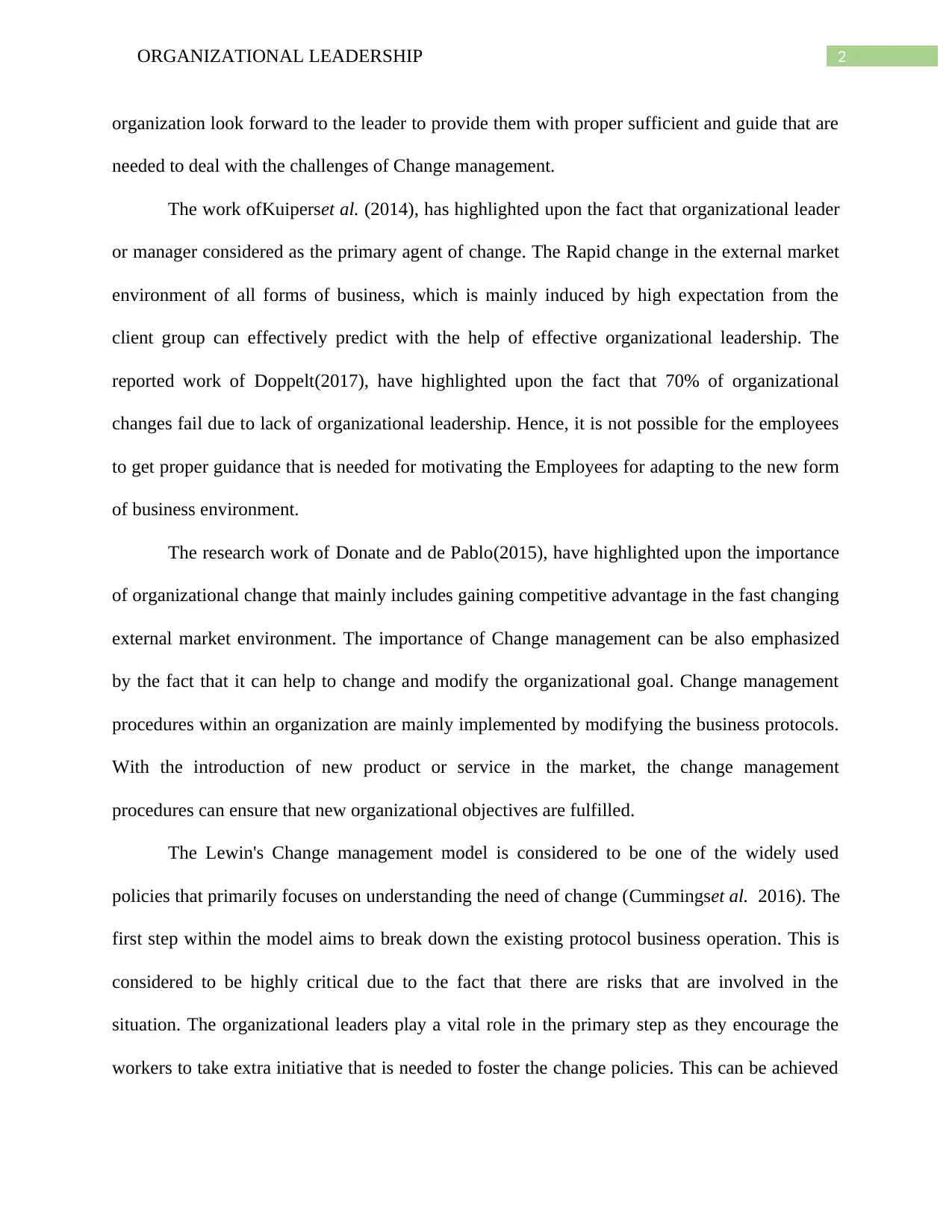
2ORGANIZATIONAL LEADERSHIP
organization look forward to the leader to provide them with proper sufficient and guide that are
needed to deal with the challenges of Change management.
The work ofKuiperset al. (2014), has highlighted upon the fact that organizational leader
or manager considered as the primary agent of change. The Rapid change in the external market
environment of all forms of business, which is mainly induced by high expectation from the
client group can effectively predict with the help of effective organizational leadership. The
reported work of Doppelt(2017), have highlighted upon the fact that 70% of organizational
changes fail due to lack of organizational leadership. Hence, it is not possible for the employees
to get proper guidance that is needed for motivating the Employees for adapting to the new form
of business environment.
The research work of Donate and de Pablo(2015), have highlighted upon the importance
of organizational change that mainly includes gaining competitive advantage in the fast changing
external market environment. The importance of Change management can be also emphasized
by the fact that it can help to change and modify the organizational goal. Change management
procedures within an organization are mainly implemented by modifying the business protocols.
With the introduction of new product or service in the market, the change management
procedures can ensure that new organizational objectives are fulfilled.
The Lewin's Change management model is considered to be one of the widely used
policies that primarily focuses on understanding the need of change (Cummingset al. 2016). The
first step within the model aims to break down the existing protocol business operation. This is
considered to be highly critical due to the fact that there are risks that are involved in the
situation. The organizational leaders play a vital role in the primary step as they encourage the
workers to take extra initiative that is needed to foster the change policies. This can be achieved
organization look forward to the leader to provide them with proper sufficient and guide that are
needed to deal with the challenges of Change management.
The work ofKuiperset al. (2014), has highlighted upon the fact that organizational leader
or manager considered as the primary agent of change. The Rapid change in the external market
environment of all forms of business, which is mainly induced by high expectation from the
client group can effectively predict with the help of effective organizational leadership. The
reported work of Doppelt(2017), have highlighted upon the fact that 70% of organizational
changes fail due to lack of organizational leadership. Hence, it is not possible for the employees
to get proper guidance that is needed for motivating the Employees for adapting to the new form
of business environment.
The research work of Donate and de Pablo(2015), have highlighted upon the importance
of organizational change that mainly includes gaining competitive advantage in the fast changing
external market environment. The importance of Change management can be also emphasized
by the fact that it can help to change and modify the organizational goal. Change management
procedures within an organization are mainly implemented by modifying the business protocols.
With the introduction of new product or service in the market, the change management
procedures can ensure that new organizational objectives are fulfilled.
The Lewin's Change management model is considered to be one of the widely used
policies that primarily focuses on understanding the need of change (Cummingset al. 2016). The
first step within the model aims to break down the existing protocol business operation. This is
considered to be highly critical due to the fact that there are risks that are involved in the
situation. The organizational leaders play a vital role in the primary step as they encourage the
workers to take extra initiative that is needed to foster the change policies. This can be achieved
⊘ This is a preview!⊘
Do you want full access?
Subscribe today to unlock all pages.

Trusted by 1+ million students worldwide
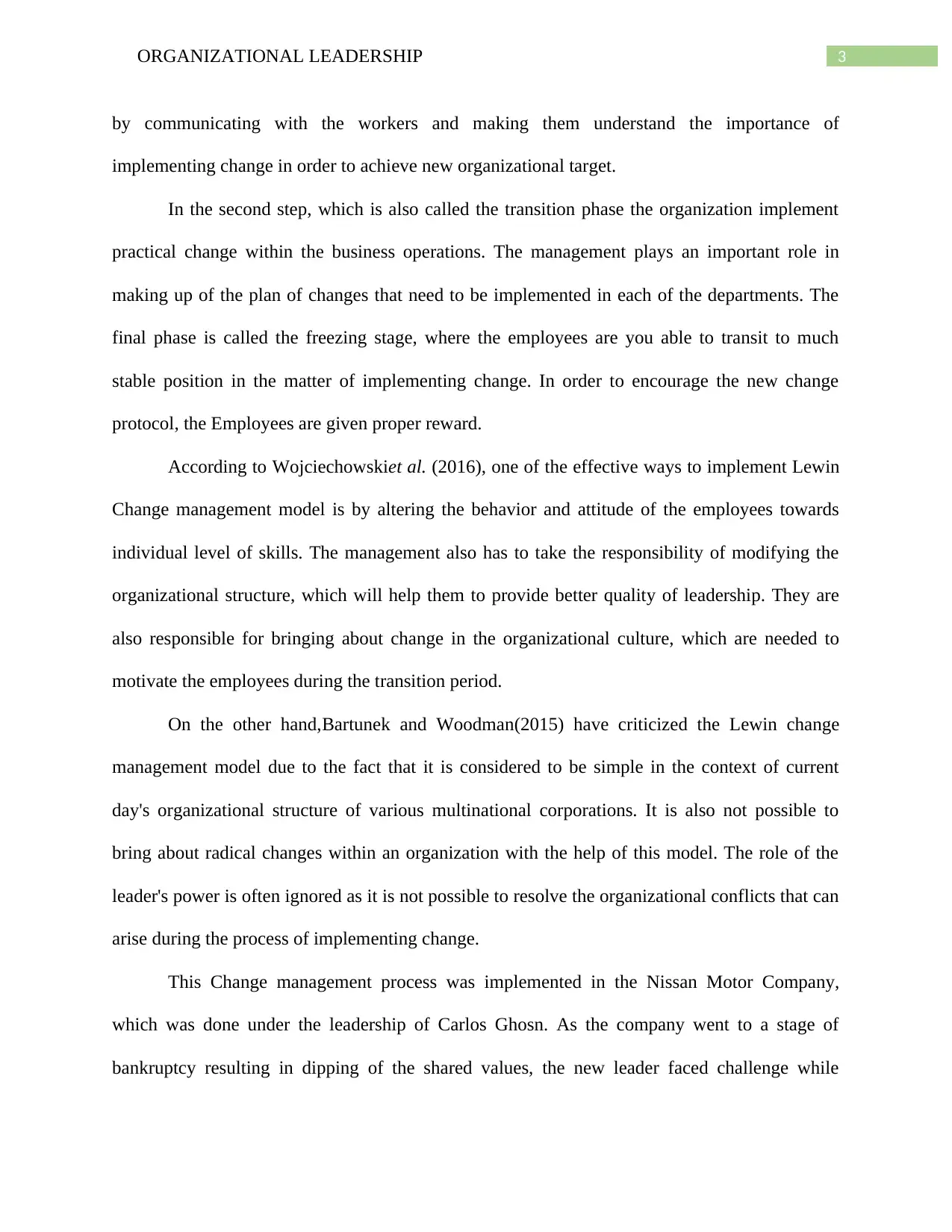
3ORGANIZATIONAL LEADERSHIP
by communicating with the workers and making them understand the importance of
implementing change in order to achieve new organizational target.
In the second step, which is also called the transition phase the organization implement
practical change within the business operations. The management plays an important role in
making up of the plan of changes that need to be implemented in each of the departments. The
final phase is called the freezing stage, where the employees are you able to transit to much
stable position in the matter of implementing change. In order to encourage the new change
protocol, the Employees are given proper reward.
According to Wojciechowskiet al. (2016), one of the effective ways to implement Lewin
Change management model is by altering the behavior and attitude of the employees towards
individual level of skills. The management also has to take the responsibility of modifying the
organizational structure, which will help them to provide better quality of leadership. They are
also responsible for bringing about change in the organizational culture, which are needed to
motivate the employees during the transition period.
On the other hand,Bartunek and Woodman(2015) have criticized the Lewin change
management model due to the fact that it is considered to be simple in the context of current
day's organizational structure of various multinational corporations. It is also not possible to
bring about radical changes within an organization with the help of this model. The role of the
leader's power is often ignored as it is not possible to resolve the organizational conflicts that can
arise during the process of implementing change.
This Change management process was implemented in the Nissan Motor Company,
which was done under the leadership of Carlos Ghosn. As the company went to a stage of
bankruptcy resulting in dipping of the shared values, the new leader faced challenge while
by communicating with the workers and making them understand the importance of
implementing change in order to achieve new organizational target.
In the second step, which is also called the transition phase the organization implement
practical change within the business operations. The management plays an important role in
making up of the plan of changes that need to be implemented in each of the departments. The
final phase is called the freezing stage, where the employees are you able to transit to much
stable position in the matter of implementing change. In order to encourage the new change
protocol, the Employees are given proper reward.
According to Wojciechowskiet al. (2016), one of the effective ways to implement Lewin
Change management model is by altering the behavior and attitude of the employees towards
individual level of skills. The management also has to take the responsibility of modifying the
organizational structure, which will help them to provide better quality of leadership. They are
also responsible for bringing about change in the organizational culture, which are needed to
motivate the employees during the transition period.
On the other hand,Bartunek and Woodman(2015) have criticized the Lewin change
management model due to the fact that it is considered to be simple in the context of current
day's organizational structure of various multinational corporations. It is also not possible to
bring about radical changes within an organization with the help of this model. The role of the
leader's power is often ignored as it is not possible to resolve the organizational conflicts that can
arise during the process of implementing change.
This Change management process was implemented in the Nissan Motor Company,
which was done under the leadership of Carlos Ghosn. As the company went to a stage of
bankruptcy resulting in dipping of the shared values, the new leader faced challenge while
Paraphrase This Document
Need a fresh take? Get an instant paraphrase of this document with our AI Paraphraser
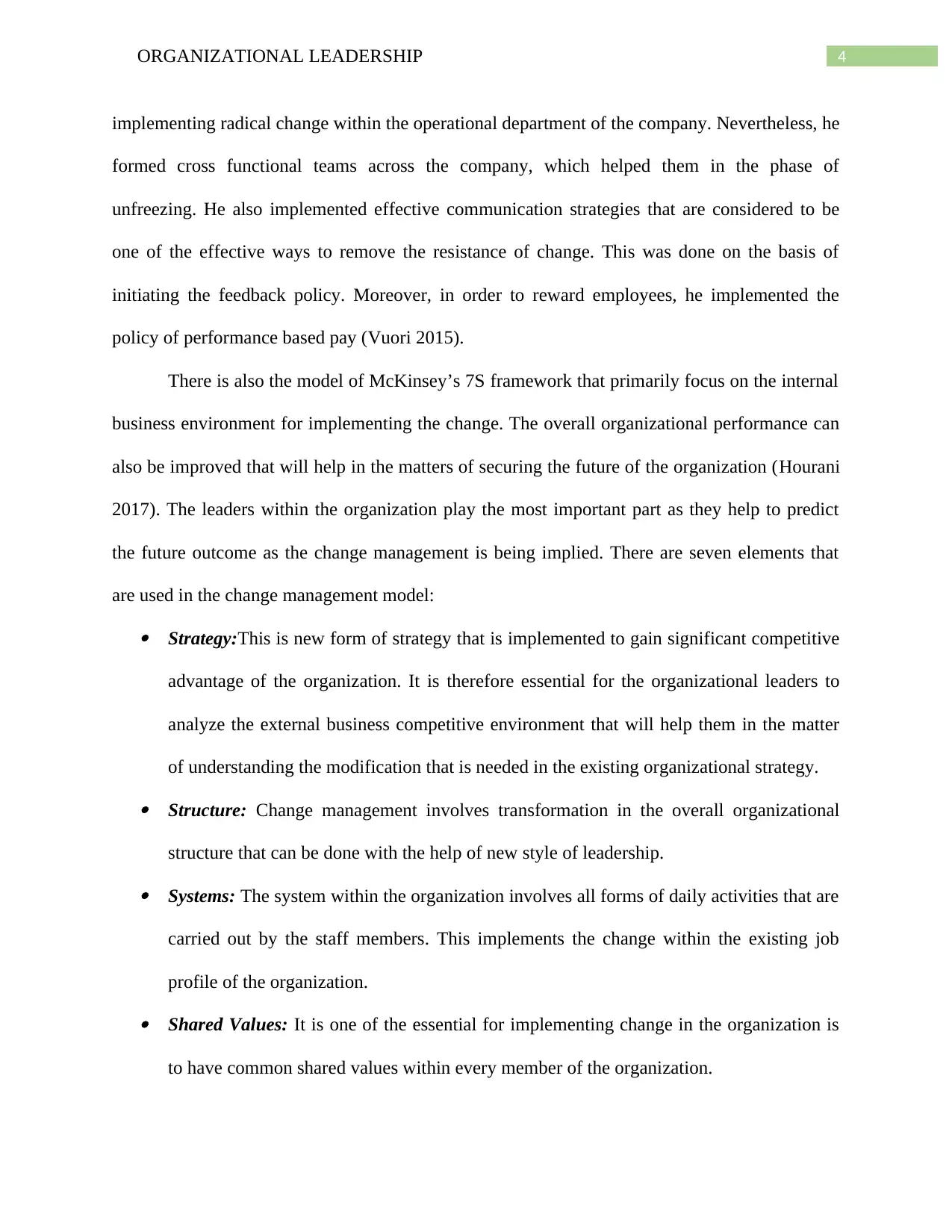
4ORGANIZATIONAL LEADERSHIP
implementing radical change within the operational department of the company. Nevertheless, he
formed cross functional teams across the company, which helped them in the phase of
unfreezing. He also implemented effective communication strategies that are considered to be
one of the effective ways to remove the resistance of change. This was done on the basis of
initiating the feedback policy. Moreover, in order to reward employees, he implemented the
policy of performance based pay (Vuori 2015).
There is also the model of McKinsey’s 7S framework that primarily focus on the internal
business environment for implementing the change. The overall organizational performance can
also be improved that will help in the matters of securing the future of the organization (Hourani
2017). The leaders within the organization play the most important part as they help to predict
the future outcome as the change management is being implied. There are seven elements that
are used in the change management model: Strategy:This is new form of strategy that is implemented to gain significant competitive
advantage of the organization. It is therefore essential for the organizational leaders to
analyze the external business competitive environment that will help them in the matter
of understanding the modification that is needed in the existing organizational strategy. Structure: Change management involves transformation in the overall organizational
structure that can be done with the help of new style of leadership. Systems: The system within the organization involves all forms of daily activities that are
carried out by the staff members. This implements the change within the existing job
profile of the organization. Shared Values: It is one of the essential for implementing change in the organization is
to have common shared values within every member of the organization.
implementing radical change within the operational department of the company. Nevertheless, he
formed cross functional teams across the company, which helped them in the phase of
unfreezing. He also implemented effective communication strategies that are considered to be
one of the effective ways to remove the resistance of change. This was done on the basis of
initiating the feedback policy. Moreover, in order to reward employees, he implemented the
policy of performance based pay (Vuori 2015).
There is also the model of McKinsey’s 7S framework that primarily focus on the internal
business environment for implementing the change. The overall organizational performance can
also be improved that will help in the matters of securing the future of the organization (Hourani
2017). The leaders within the organization play the most important part as they help to predict
the future outcome as the change management is being implied. There are seven elements that
are used in the change management model: Strategy:This is new form of strategy that is implemented to gain significant competitive
advantage of the organization. It is therefore essential for the organizational leaders to
analyze the external business competitive environment that will help them in the matter
of understanding the modification that is needed in the existing organizational strategy. Structure: Change management involves transformation in the overall organizational
structure that can be done with the help of new style of leadership. Systems: The system within the organization involves all forms of daily activities that are
carried out by the staff members. This implements the change within the existing job
profile of the organization. Shared Values: It is one of the essential for implementing change in the organization is
to have common shared values within every member of the organization.
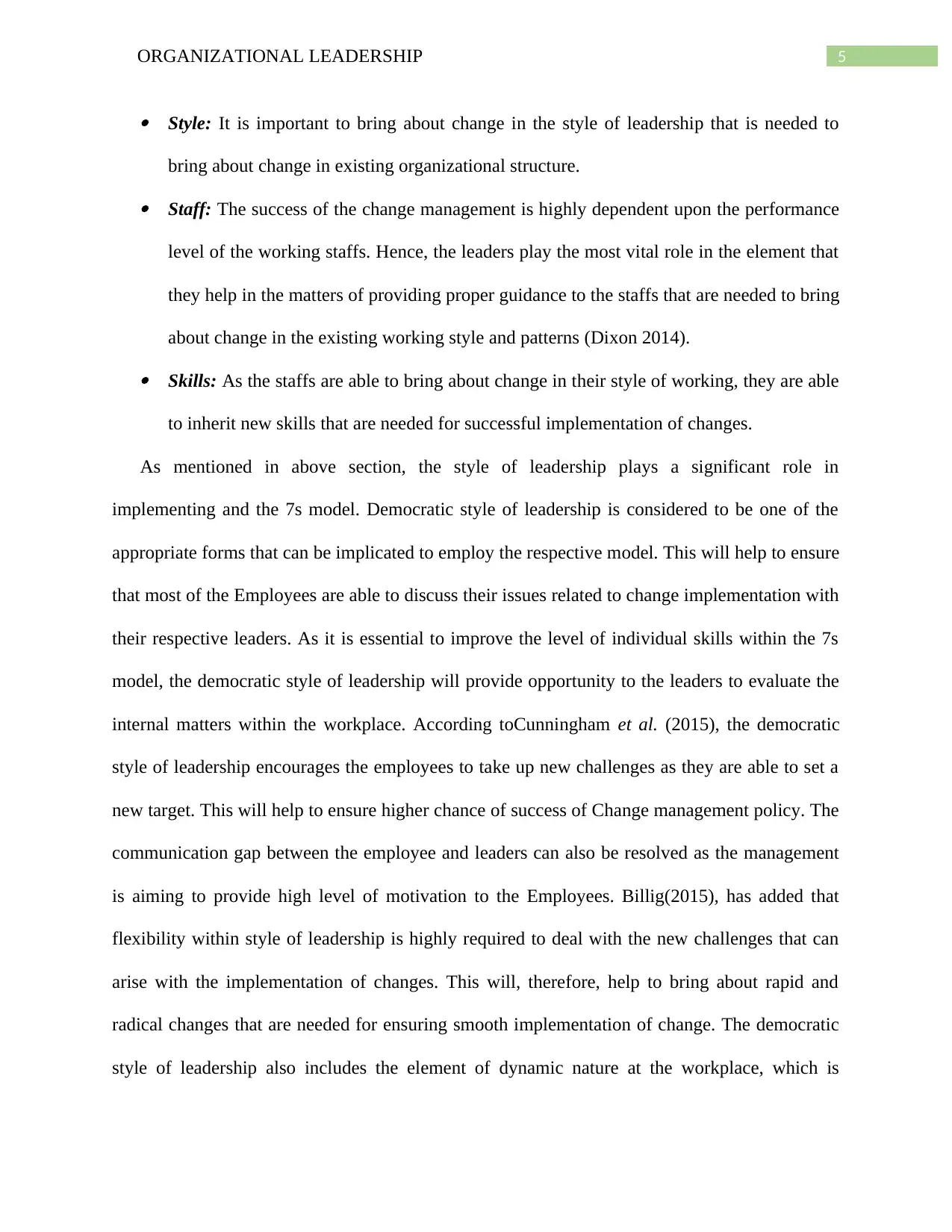
5ORGANIZATIONAL LEADERSHIP
Style: It is important to bring about change in the style of leadership that is needed to
bring about change in existing organizational structure. Staff: The success of the change management is highly dependent upon the performance
level of the working staffs. Hence, the leaders play the most vital role in the element that
they help in the matters of providing proper guidance to the staffs that are needed to bring
about change in the existing working style and patterns (Dixon 2014). Skills: As the staffs are able to bring about change in their style of working, they are able
to inherit new skills that are needed for successful implementation of changes.
As mentioned in above section, the style of leadership plays a significant role in
implementing and the 7s model. Democratic style of leadership is considered to be one of the
appropriate forms that can be implicated to employ the respective model. This will help to ensure
that most of the Employees are able to discuss their issues related to change implementation with
their respective leaders. As it is essential to improve the level of individual skills within the 7s
model, the democratic style of leadership will provide opportunity to the leaders to evaluate the
internal matters within the workplace. According toCunningham et al. (2015), the democratic
style of leadership encourages the employees to take up new challenges as they are able to set a
new target. This will help to ensure higher chance of success of Change management policy. The
communication gap between the employee and leaders can also be resolved as the management
is aiming to provide high level of motivation to the Employees. Billig(2015), has added that
flexibility within style of leadership is highly required to deal with the new challenges that can
arise with the implementation of changes. This will, therefore, help to bring about rapid and
radical changes that are needed for ensuring smooth implementation of change. The democratic
style of leadership also includes the element of dynamic nature at the workplace, which is
Style: It is important to bring about change in the style of leadership that is needed to
bring about change in existing organizational structure. Staff: The success of the change management is highly dependent upon the performance
level of the working staffs. Hence, the leaders play the most vital role in the element that
they help in the matters of providing proper guidance to the staffs that are needed to bring
about change in the existing working style and patterns (Dixon 2014). Skills: As the staffs are able to bring about change in their style of working, they are able
to inherit new skills that are needed for successful implementation of changes.
As mentioned in above section, the style of leadership plays a significant role in
implementing and the 7s model. Democratic style of leadership is considered to be one of the
appropriate forms that can be implicated to employ the respective model. This will help to ensure
that most of the Employees are able to discuss their issues related to change implementation with
their respective leaders. As it is essential to improve the level of individual skills within the 7s
model, the democratic style of leadership will provide opportunity to the leaders to evaluate the
internal matters within the workplace. According toCunningham et al. (2015), the democratic
style of leadership encourages the employees to take up new challenges as they are able to set a
new target. This will help to ensure higher chance of success of Change management policy. The
communication gap between the employee and leaders can also be resolved as the management
is aiming to provide high level of motivation to the Employees. Billig(2015), has added that
flexibility within style of leadership is highly required to deal with the new challenges that can
arise with the implementation of changes. This will, therefore, help to bring about rapid and
radical changes that are needed for ensuring smooth implementation of change. The democratic
style of leadership also includes the element of dynamic nature at the workplace, which is
⊘ This is a preview!⊘
Do you want full access?
Subscribe today to unlock all pages.

Trusted by 1+ million students worldwide
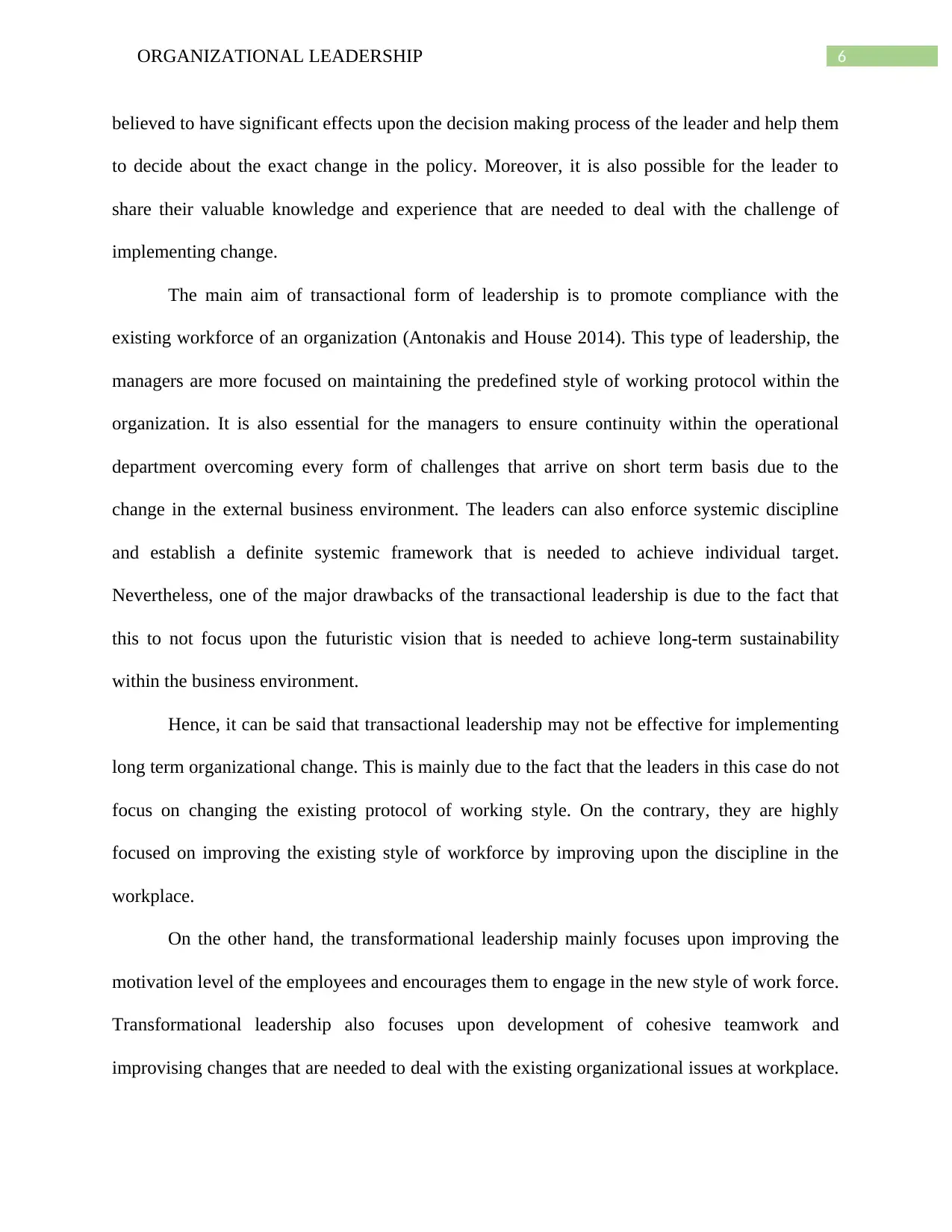
6ORGANIZATIONAL LEADERSHIP
believed to have significant effects upon the decision making process of the leader and help them
to decide about the exact change in the policy. Moreover, it is also possible for the leader to
share their valuable knowledge and experience that are needed to deal with the challenge of
implementing change.
The main aim of transactional form of leadership is to promote compliance with the
existing workforce of an organization (Antonakis and House 2014). This type of leadership, the
managers are more focused on maintaining the predefined style of working protocol within the
organization. It is also essential for the managers to ensure continuity within the operational
department overcoming every form of challenges that arrive on short term basis due to the
change in the external business environment. The leaders can also enforce systemic discipline
and establish a definite systemic framework that is needed to achieve individual target.
Nevertheless, one of the major drawbacks of the transactional leadership is due to the fact that
this to not focus upon the futuristic vision that is needed to achieve long-term sustainability
within the business environment.
Hence, it can be said that transactional leadership may not be effective for implementing
long term organizational change. This is mainly due to the fact that the leaders in this case do not
focus on changing the existing protocol of working style. On the contrary, they are highly
focused on improving the existing style of workforce by improving upon the discipline in the
workplace.
On the other hand, the transformational leadership mainly focuses upon improving the
motivation level of the employees and encourages them to engage in the new style of work force.
Transformational leadership also focuses upon development of cohesive teamwork and
improvising changes that are needed to deal with the existing organizational issues at workplace.
believed to have significant effects upon the decision making process of the leader and help them
to decide about the exact change in the policy. Moreover, it is also possible for the leader to
share their valuable knowledge and experience that are needed to deal with the challenge of
implementing change.
The main aim of transactional form of leadership is to promote compliance with the
existing workforce of an organization (Antonakis and House 2014). This type of leadership, the
managers are more focused on maintaining the predefined style of working protocol within the
organization. It is also essential for the managers to ensure continuity within the operational
department overcoming every form of challenges that arrive on short term basis due to the
change in the external business environment. The leaders can also enforce systemic discipline
and establish a definite systemic framework that is needed to achieve individual target.
Nevertheless, one of the major drawbacks of the transactional leadership is due to the fact that
this to not focus upon the futuristic vision that is needed to achieve long-term sustainability
within the business environment.
Hence, it can be said that transactional leadership may not be effective for implementing
long term organizational change. This is mainly due to the fact that the leaders in this case do not
focus on changing the existing protocol of working style. On the contrary, they are highly
focused on improving the existing style of workforce by improving upon the discipline in the
workplace.
On the other hand, the transformational leadership mainly focuses upon improving the
motivation level of the employees and encourages them to engage in the new style of work force.
Transformational leadership also focuses upon development of cohesive teamwork and
improvising changes that are needed to deal with the existing organizational issues at workplace.
Paraphrase This Document
Need a fresh take? Get an instant paraphrase of this document with our AI Paraphraser
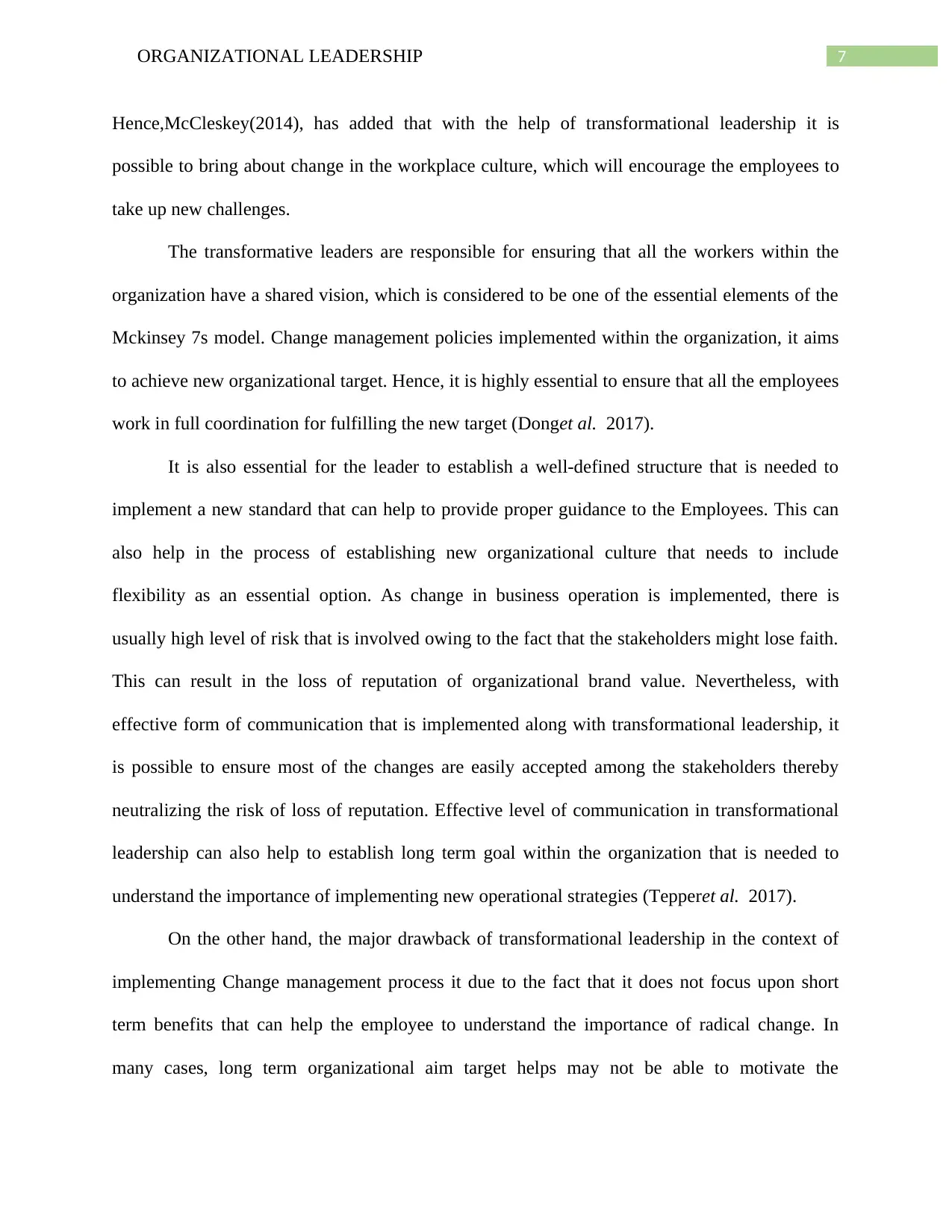
7ORGANIZATIONAL LEADERSHIP
Hence,McCleskey(2014), has added that with the help of transformational leadership it is
possible to bring about change in the workplace culture, which will encourage the employees to
take up new challenges.
The transformative leaders are responsible for ensuring that all the workers within the
organization have a shared vision, which is considered to be one of the essential elements of the
Mckinsey 7s model. Change management policies implemented within the organization, it aims
to achieve new organizational target. Hence, it is highly essential to ensure that all the employees
work in full coordination for fulfilling the new target (Donget al. 2017).
It is also essential for the leader to establish a well-defined structure that is needed to
implement a new standard that can help to provide proper guidance to the Employees. This can
also help in the process of establishing new organizational culture that needs to include
flexibility as an essential option. As change in business operation is implemented, there is
usually high level of risk that is involved owing to the fact that the stakeholders might lose faith.
This can result in the loss of reputation of organizational brand value. Nevertheless, with
effective form of communication that is implemented along with transformational leadership, it
is possible to ensure most of the changes are easily accepted among the stakeholders thereby
neutralizing the risk of loss of reputation. Effective level of communication in transformational
leadership can also help to establish long term goal within the organization that is needed to
understand the importance of implementing new operational strategies (Tepperet al. 2017).
On the other hand, the major drawback of transformational leadership in the context of
implementing Change management process it due to the fact that it does not focus upon short
term benefits that can help the employee to understand the importance of radical change. In
many cases, long term organizational aim target helps may not be able to motivate the
Hence,McCleskey(2014), has added that with the help of transformational leadership it is
possible to bring about change in the workplace culture, which will encourage the employees to
take up new challenges.
The transformative leaders are responsible for ensuring that all the workers within the
organization have a shared vision, which is considered to be one of the essential elements of the
Mckinsey 7s model. Change management policies implemented within the organization, it aims
to achieve new organizational target. Hence, it is highly essential to ensure that all the employees
work in full coordination for fulfilling the new target (Donget al. 2017).
It is also essential for the leader to establish a well-defined structure that is needed to
implement a new standard that can help to provide proper guidance to the Employees. This can
also help in the process of establishing new organizational culture that needs to include
flexibility as an essential option. As change in business operation is implemented, there is
usually high level of risk that is involved owing to the fact that the stakeholders might lose faith.
This can result in the loss of reputation of organizational brand value. Nevertheless, with
effective form of communication that is implemented along with transformational leadership, it
is possible to ensure most of the changes are easily accepted among the stakeholders thereby
neutralizing the risk of loss of reputation. Effective level of communication in transformational
leadership can also help to establish long term goal within the organization that is needed to
understand the importance of implementing new operational strategies (Tepperet al. 2017).
On the other hand, the major drawback of transformational leadership in the context of
implementing Change management process it due to the fact that it does not focus upon short
term benefits that can help the employee to understand the importance of radical change. In
many cases, long term organizational aim target helps may not be able to motivate the
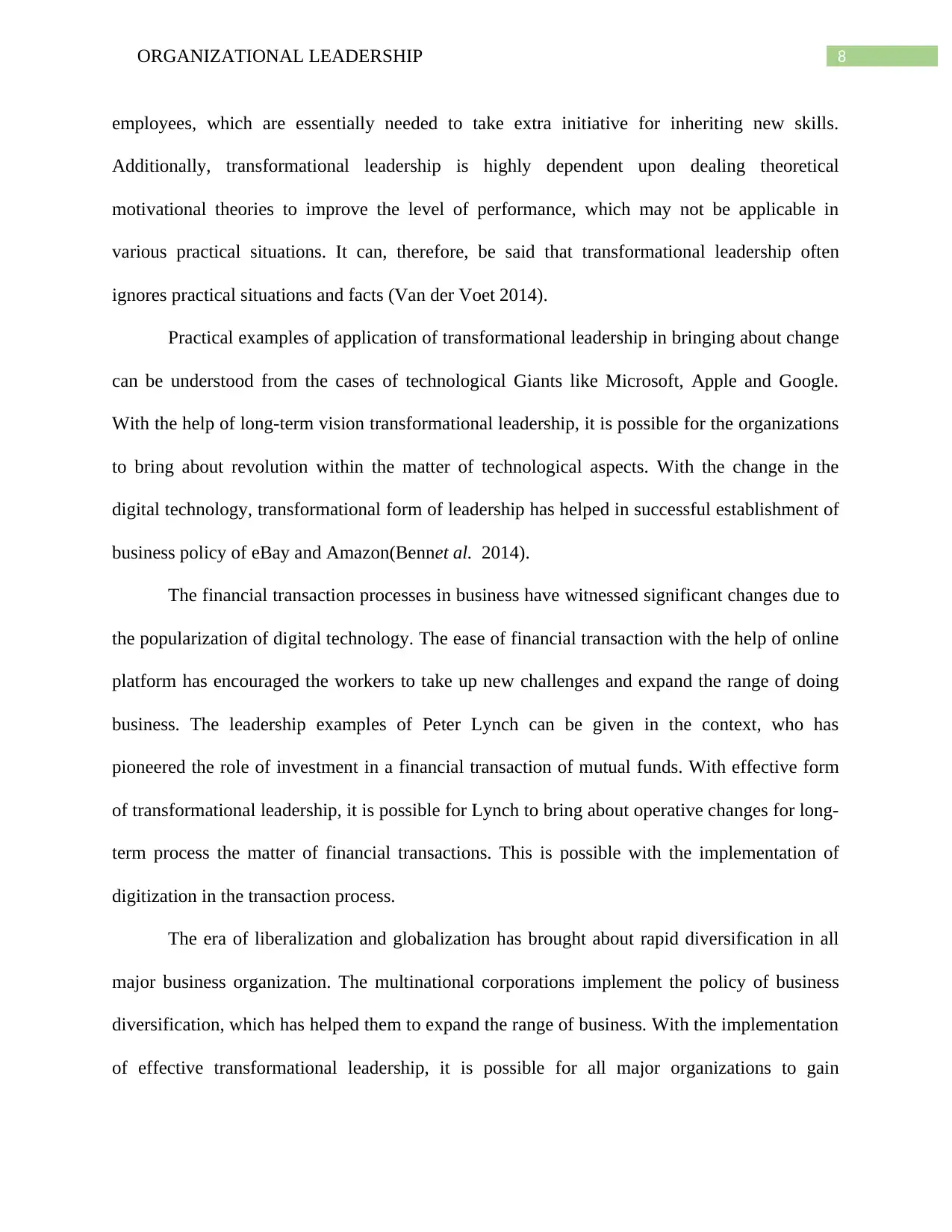
8ORGANIZATIONAL LEADERSHIP
employees, which are essentially needed to take extra initiative for inheriting new skills.
Additionally, transformational leadership is highly dependent upon dealing theoretical
motivational theories to improve the level of performance, which may not be applicable in
various practical situations. It can, therefore, be said that transformational leadership often
ignores practical situations and facts (Van der Voet 2014).
Practical examples of application of transformational leadership in bringing about change
can be understood from the cases of technological Giants like Microsoft, Apple and Google.
With the help of long-term vision transformational leadership, it is possible for the organizations
to bring about revolution within the matter of technological aspects. With the change in the
digital technology, transformational form of leadership has helped in successful establishment of
business policy of eBay and Amazon(Bennet al. 2014).
The financial transaction processes in business have witnessed significant changes due to
the popularization of digital technology. The ease of financial transaction with the help of online
platform has encouraged the workers to take up new challenges and expand the range of doing
business. The leadership examples of Peter Lynch can be given in the context, who has
pioneered the role of investment in a financial transaction of mutual funds. With effective form
of transformational leadership, it is possible for Lynch to bring about operative changes for long-
term process the matter of financial transactions. This is possible with the implementation of
digitization in the transaction process.
The era of liberalization and globalization has brought about rapid diversification in all
major business organization. The multinational corporations implement the policy of business
diversification, which has helped them to expand the range of business. With the implementation
of effective transformational leadership, it is possible for all major organizations to gain
employees, which are essentially needed to take extra initiative for inheriting new skills.
Additionally, transformational leadership is highly dependent upon dealing theoretical
motivational theories to improve the level of performance, which may not be applicable in
various practical situations. It can, therefore, be said that transformational leadership often
ignores practical situations and facts (Van der Voet 2014).
Practical examples of application of transformational leadership in bringing about change
can be understood from the cases of technological Giants like Microsoft, Apple and Google.
With the help of long-term vision transformational leadership, it is possible for the organizations
to bring about revolution within the matter of technological aspects. With the change in the
digital technology, transformational form of leadership has helped in successful establishment of
business policy of eBay and Amazon(Bennet al. 2014).
The financial transaction processes in business have witnessed significant changes due to
the popularization of digital technology. The ease of financial transaction with the help of online
platform has encouraged the workers to take up new challenges and expand the range of doing
business. The leadership examples of Peter Lynch can be given in the context, who has
pioneered the role of investment in a financial transaction of mutual funds. With effective form
of transformational leadership, it is possible for Lynch to bring about operative changes for long-
term process the matter of financial transactions. This is possible with the implementation of
digitization in the transaction process.
The era of liberalization and globalization has brought about rapid diversification in all
major business organization. The multinational corporations implement the policy of business
diversification, which has helped them to expand the range of business. With the implementation
of effective transformational leadership, it is possible for all major organizations to gain
⊘ This is a preview!⊘
Do you want full access?
Subscribe today to unlock all pages.

Trusted by 1+ million students worldwide
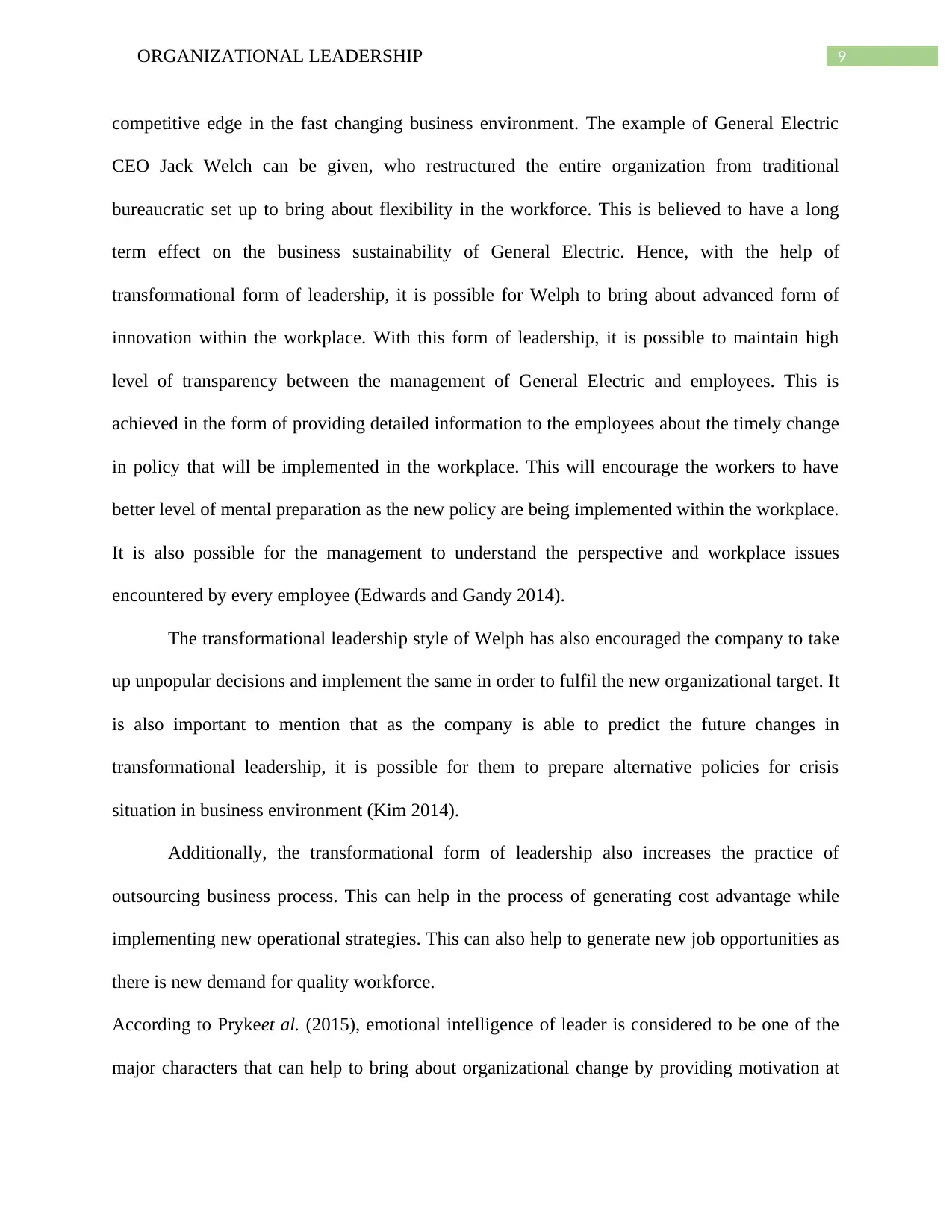
9ORGANIZATIONAL LEADERSHIP
competitive edge in the fast changing business environment. The example of General Electric
CEO Jack Welch can be given, who restructured the entire organization from traditional
bureaucratic set up to bring about flexibility in the workforce. This is believed to have a long
term effect on the business sustainability of General Electric. Hence, with the help of
transformational form of leadership, it is possible for Welph to bring about advanced form of
innovation within the workplace. With this form of leadership, it is possible to maintain high
level of transparency between the management of General Electric and employees. This is
achieved in the form of providing detailed information to the employees about the timely change
in policy that will be implemented in the workplace. This will encourage the workers to have
better level of mental preparation as the new policy are being implemented within the workplace.
It is also possible for the management to understand the perspective and workplace issues
encountered by every employee (Edwards and Gandy 2014).
The transformational leadership style of Welph has also encouraged the company to take
up unpopular decisions and implement the same in order to fulfil the new organizational target. It
is also important to mention that as the company is able to predict the future changes in
transformational leadership, it is possible for them to prepare alternative policies for crisis
situation in business environment (Kim 2014).
Additionally, the transformational form of leadership also increases the practice of
outsourcing business process. This can help in the process of generating cost advantage while
implementing new operational strategies. This can also help to generate new job opportunities as
there is new demand for quality workforce.
According to Prykeet al. (2015), emotional intelligence of leader is considered to be one of the
major characters that can help to bring about organizational change by providing motivation at
competitive edge in the fast changing business environment. The example of General Electric
CEO Jack Welch can be given, who restructured the entire organization from traditional
bureaucratic set up to bring about flexibility in the workforce. This is believed to have a long
term effect on the business sustainability of General Electric. Hence, with the help of
transformational form of leadership, it is possible for Welph to bring about advanced form of
innovation within the workplace. With this form of leadership, it is possible to maintain high
level of transparency between the management of General Electric and employees. This is
achieved in the form of providing detailed information to the employees about the timely change
in policy that will be implemented in the workplace. This will encourage the workers to have
better level of mental preparation as the new policy are being implemented within the workplace.
It is also possible for the management to understand the perspective and workplace issues
encountered by every employee (Edwards and Gandy 2014).
The transformational leadership style of Welph has also encouraged the company to take
up unpopular decisions and implement the same in order to fulfil the new organizational target. It
is also important to mention that as the company is able to predict the future changes in
transformational leadership, it is possible for them to prepare alternative policies for crisis
situation in business environment (Kim 2014).
Additionally, the transformational form of leadership also increases the practice of
outsourcing business process. This can help in the process of generating cost advantage while
implementing new operational strategies. This can also help to generate new job opportunities as
there is new demand for quality workforce.
According to Prykeet al. (2015), emotional intelligence of leader is considered to be one of the
major characters that can help to bring about organizational change by providing motivation at
Paraphrase This Document
Need a fresh take? Get an instant paraphrase of this document with our AI Paraphraser
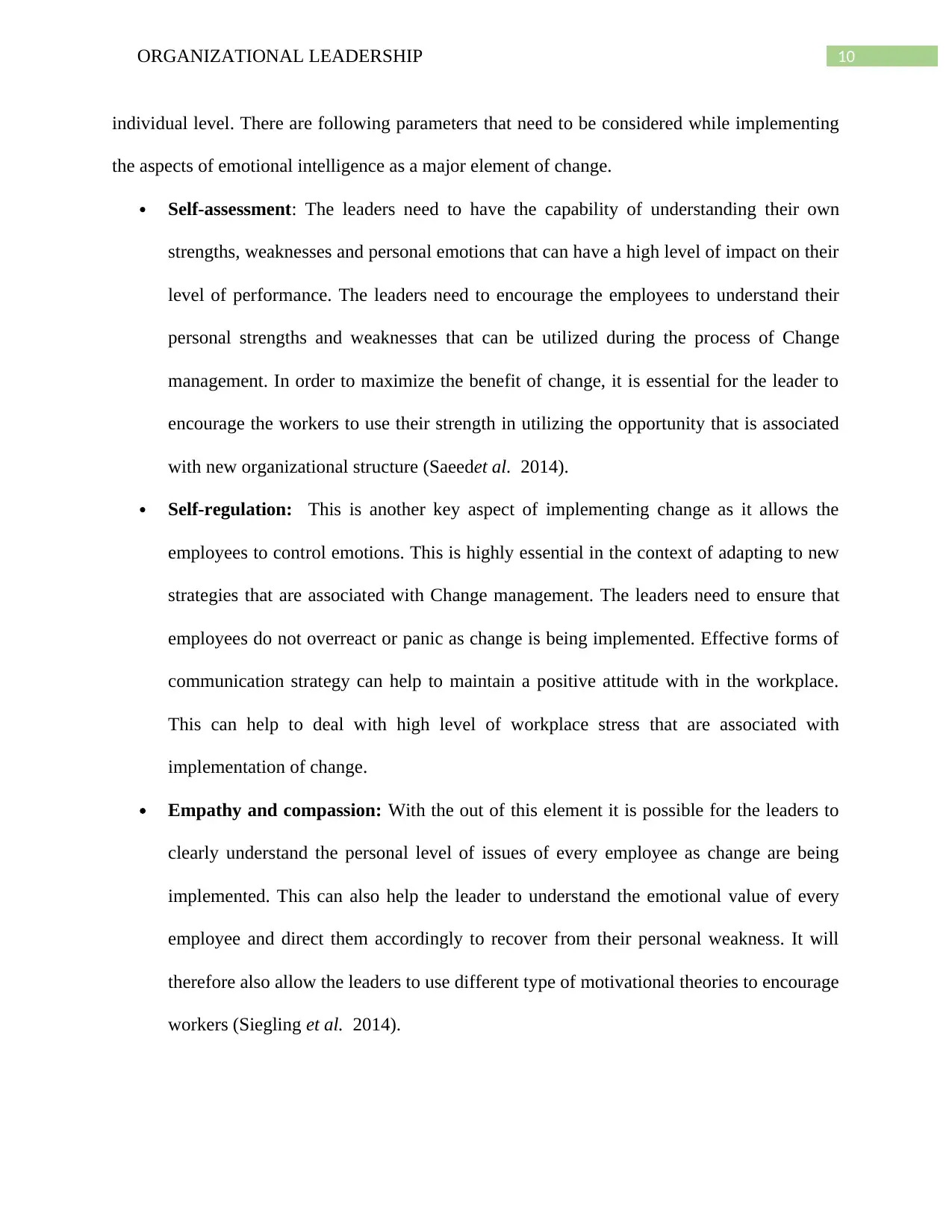
10ORGANIZATIONAL LEADERSHIP
individual level. There are following parameters that need to be considered while implementing
the aspects of emotional intelligence as a major element of change.
Self-assessment: The leaders need to have the capability of understanding their own
strengths, weaknesses and personal emotions that can have a high level of impact on their
level of performance. The leaders need to encourage the employees to understand their
personal strengths and weaknesses that can be utilized during the process of Change
management. In order to maximize the benefit of change, it is essential for the leader to
encourage the workers to use their strength in utilizing the opportunity that is associated
with new organizational structure (Saeedet al. 2014).
Self-regulation: This is another key aspect of implementing change as it allows the
employees to control emotions. This is highly essential in the context of adapting to new
strategies that are associated with Change management. The leaders need to ensure that
employees do not overreact or panic as change is being implemented. Effective forms of
communication strategy can help to maintain a positive attitude with in the workplace.
This can help to deal with high level of workplace stress that are associated with
implementation of change.
Empathy and compassion: With the out of this element it is possible for the leaders to
clearly understand the personal level of issues of every employee as change are being
implemented. This can also help the leader to understand the emotional value of every
employee and direct them accordingly to recover from their personal weakness. It will
therefore also allow the leaders to use different type of motivational theories to encourage
workers (Siegling et al. 2014).
individual level. There are following parameters that need to be considered while implementing
the aspects of emotional intelligence as a major element of change.
Self-assessment: The leaders need to have the capability of understanding their own
strengths, weaknesses and personal emotions that can have a high level of impact on their
level of performance. The leaders need to encourage the employees to understand their
personal strengths and weaknesses that can be utilized during the process of Change
management. In order to maximize the benefit of change, it is essential for the leader to
encourage the workers to use their strength in utilizing the opportunity that is associated
with new organizational structure (Saeedet al. 2014).
Self-regulation: This is another key aspect of implementing change as it allows the
employees to control emotions. This is highly essential in the context of adapting to new
strategies that are associated with Change management. The leaders need to ensure that
employees do not overreact or panic as change is being implemented. Effective forms of
communication strategy can help to maintain a positive attitude with in the workplace.
This can help to deal with high level of workplace stress that are associated with
implementation of change.
Empathy and compassion: With the out of this element it is possible for the leaders to
clearly understand the personal level of issues of every employee as change are being
implemented. This can also help the leader to understand the emotional value of every
employee and direct them accordingly to recover from their personal weakness. It will
therefore also allow the leaders to use different type of motivational theories to encourage
workers (Siegling et al. 2014).
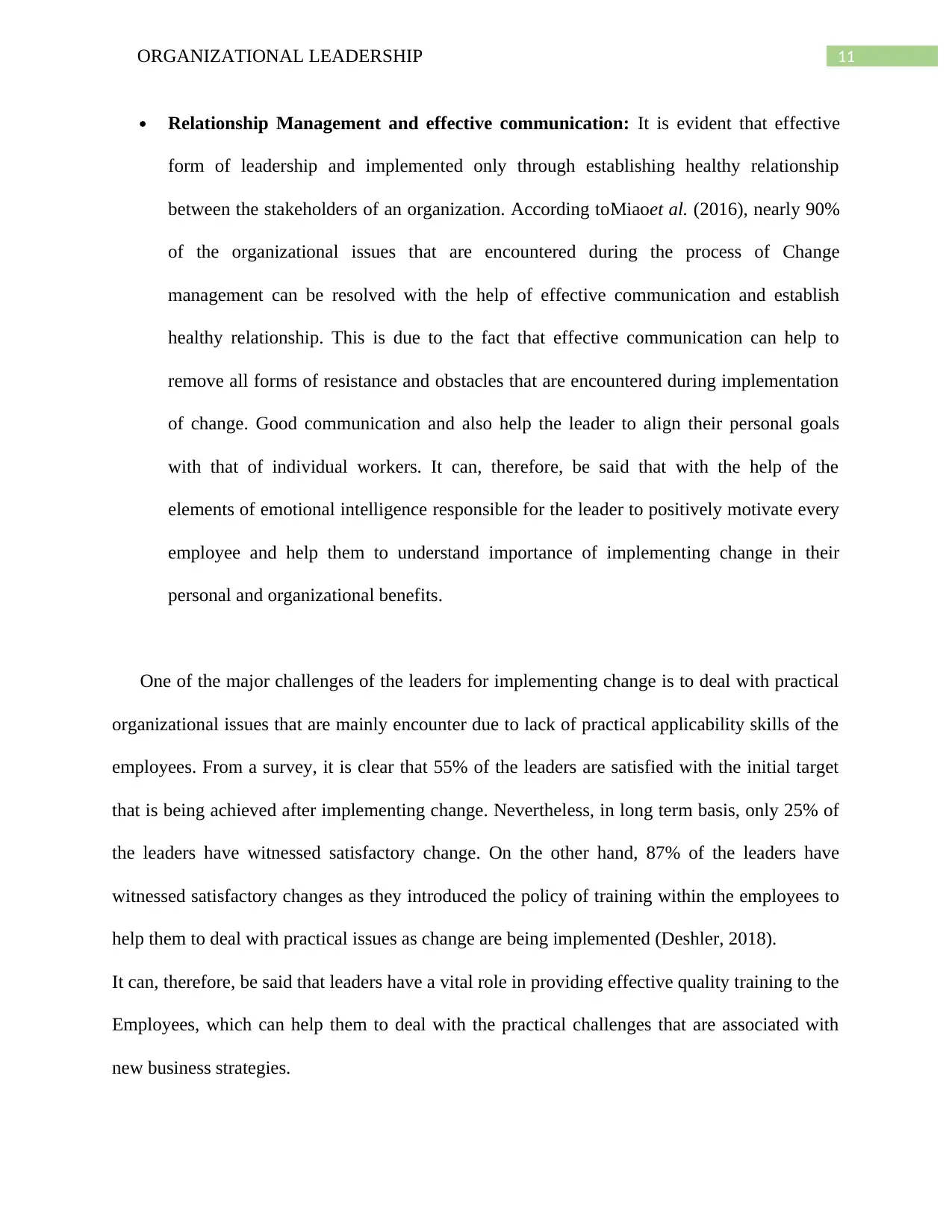
11ORGANIZATIONAL LEADERSHIP
Relationship Management and effective communication: It is evident that effective
form of leadership and implemented only through establishing healthy relationship
between the stakeholders of an organization. According toMiaoet al. (2016), nearly 90%
of the organizational issues that are encountered during the process of Change
management can be resolved with the help of effective communication and establish
healthy relationship. This is due to the fact that effective communication can help to
remove all forms of resistance and obstacles that are encountered during implementation
of change. Good communication and also help the leader to align their personal goals
with that of individual workers. It can, therefore, be said that with the help of the
elements of emotional intelligence responsible for the leader to positively motivate every
employee and help them to understand importance of implementing change in their
personal and organizational benefits.
One of the major challenges of the leaders for implementing change is to deal with practical
organizational issues that are mainly encounter due to lack of practical applicability skills of the
employees. From a survey, it is clear that 55% of the leaders are satisfied with the initial target
that is being achieved after implementing change. Nevertheless, in long term basis, only 25% of
the leaders have witnessed satisfactory change. On the other hand, 87% of the leaders have
witnessed satisfactory changes as they introduced the policy of training within the employees to
help them to deal with practical issues as change are being implemented (Deshler, 2018).
It can, therefore, be said that leaders have a vital role in providing effective quality training to the
Employees, which can help them to deal with the practical challenges that are associated with
new business strategies.
Relationship Management and effective communication: It is evident that effective
form of leadership and implemented only through establishing healthy relationship
between the stakeholders of an organization. According toMiaoet al. (2016), nearly 90%
of the organizational issues that are encountered during the process of Change
management can be resolved with the help of effective communication and establish
healthy relationship. This is due to the fact that effective communication can help to
remove all forms of resistance and obstacles that are encountered during implementation
of change. Good communication and also help the leader to align their personal goals
with that of individual workers. It can, therefore, be said that with the help of the
elements of emotional intelligence responsible for the leader to positively motivate every
employee and help them to understand importance of implementing change in their
personal and organizational benefits.
One of the major challenges of the leaders for implementing change is to deal with practical
organizational issues that are mainly encounter due to lack of practical applicability skills of the
employees. From a survey, it is clear that 55% of the leaders are satisfied with the initial target
that is being achieved after implementing change. Nevertheless, in long term basis, only 25% of
the leaders have witnessed satisfactory change. On the other hand, 87% of the leaders have
witnessed satisfactory changes as they introduced the policy of training within the employees to
help them to deal with practical issues as change are being implemented (Deshler, 2018).
It can, therefore, be said that leaders have a vital role in providing effective quality training to the
Employees, which can help them to deal with the practical challenges that are associated with
new business strategies.
⊘ This is a preview!⊘
Do you want full access?
Subscribe today to unlock all pages.

Trusted by 1+ million students worldwide
1 out of 18
Related Documents
Your All-in-One AI-Powered Toolkit for Academic Success.
+13062052269
info@desklib.com
Available 24*7 on WhatsApp / Email
![[object Object]](/_next/static/media/star-bottom.7253800d.svg)
Unlock your academic potential
Copyright © 2020–2025 A2Z Services. All Rights Reserved. Developed and managed by ZUCOL.




